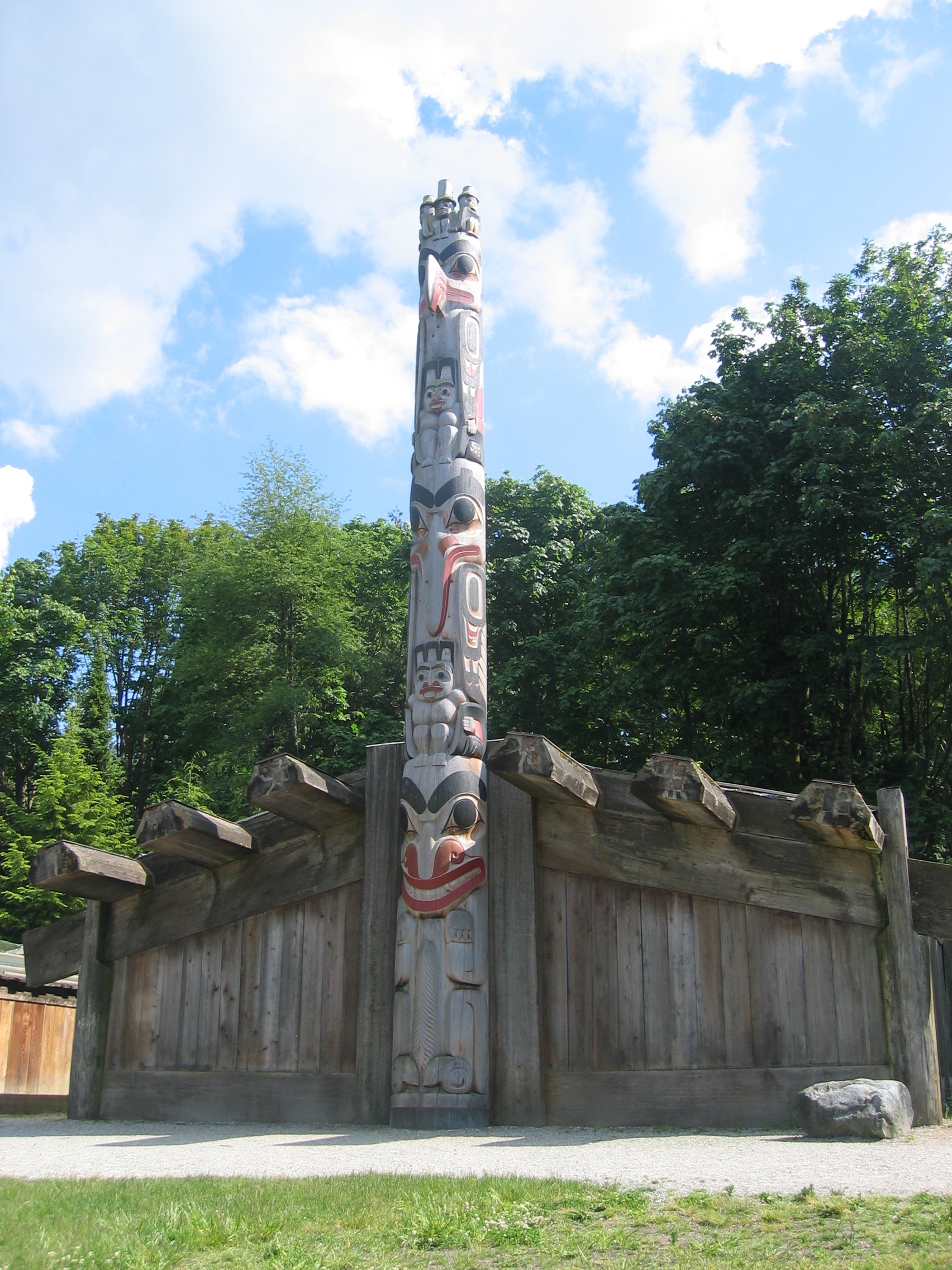|
Quiggly Hole
A quiggly hole, also known as a pit-house or simply as a quiggly or kekuli, is the remains of an earth lodge built by the First Nations people of the Interior of British Columbia and the Columbia Plateau in the United States. The word ''quiggly'' comes from a mispronunciation of the nsyilxcǝn term qʷc̓iʔ, which was incorporated into Chinook Jargon as ''kickwillie''. , kickwillie, or are the spelling variations of the Chinook Jargon word for "beneath" or "under". Appearance and location A quiggly hole appears as a circular depression in the ground, the remnants of a former log-roofed pithouse (locally named a barabara or an ulax). Quigglies generally come in large groupings known as ''quiggly towns'', some with hundreds of holes indicating a potential population of thousands. Some of these holes were residential for single family or larger groups, while some may have been storage only. Quiggly towns are typically located where solar exposure, water supply, and access to fi ... [...More Info...] [...Related Items...] OR: [Wikipedia] [Google] [Baidu] |
Pavilion, British Columbia
Pavilion is an unincorporated community on the eastern side of the Fraser River in the South Cariboo region of southwestern British Columbia. The place is near Mile 21 of the Old Cariboo Road. On BC Highway 99, the locality is by road about northeast of Lillooet and west of Kamloops. First Nations The early anglicized version of the village name was Skwailuk, meaning hoar-frost, perhaps indicating the shaded ground remaining frozen during the long winters at this elevation. The Ts'kw'aylaxw First Nation (a.k.a. the Tsk'waylacw First Nation or Tsk'weylecw First Nation), residing on the Pavilion 1 Indian Reserve comprise most of the area population. The Pavilion dialect is a mix of St'at'imcets and Secwepemc'tsn and many of the place names in the surrounding country are Secwepemc'tsn. Name origin In 1859, Lieutenant Mayne of the Royal Engineers observed the indigenous people possessed a basic fluency in French from earlier contact with the fur traders. In 1862, Mayne publis ... [...More Info...] [...Related Items...] OR: [Wikipedia] [Google] [Baidu] |
Anthropologist
An anthropologist is a scientist engaged in the practice of anthropology. Anthropologists study aspects of humans within past and present societies. Social anthropology, cultural anthropology and philosophical anthropology study the norms, values, and general behavior of societies. Linguistic anthropology studies how language affects social life, while economic anthropology studies human economic behavior. Biological (physical), forensic, and medical anthropology study the biology and evolution of humans and their primate relatives, the application of biological anthropology in a legal setting, and the study of diseases and their impacts on humans over time, respectively. Education Anthropologists usually cover a breadth of topics within anthropology in their undergraduate education and then proceed to specialize in topics of their own choice at the graduate level. In some universities, a qualifying exam serves to test both the breadth and depth of a student's understandi ... [...More Info...] [...Related Items...] OR: [Wikipedia] [Google] [Baidu] |
St̓át̓imcets Language
Lillooet (; Lillooet: / , ) is a Salishan language of the Interior branch spoken by the Stʼatʼimc in southern British Columbia, Canada, around the middle Fraser and Lillooet Rivers. The language of the Lower Lillooet people uses the name ', because ' means "the language of the people of ''Sat̓''", i.e. the Upper Lillooet of the Fraser River. Lillooet / St̓át̓imcets is a critically endangered language with around 120 fluent speakers and 393 semi-speakers. In 2022, there was a reported 1092 people learning the language. Regional varieties St̓át̓imcets has two main dialects: * ''Upper/Northern St̓át̓imcets'' ( St̓át̓imcets, Fountain) * ''Lower/Southern St̓at̓imcets'' (a.k.a. Lil̓wat7úlmec, Mount Currie) Upper St̓át̓imcets is spoken around Fountain, Pavilion, Lillooet, and neighboring areas. Lower St̓át̓imcets is spoken around Mount Currie and neighboring areas. An additional subdialect called Skookumchuck is spoken within the Lower St̓át̓imcets d ... [...More Info...] [...Related Items...] OR: [Wikipedia] [Google] [Baidu] |
Rancherie
A rancherie is a First Nations residential area of an Indian reserve in colloquial English throughout the Canadian province of British Columbia. Originating in an adaptation of ''ranchería'', a Californian term for the residential area of a '' rancho'', where most farm hands were aboriginal, the term later came to be used throughout British Columbia. In modern usage it is often a new residential area, but traditionally it is the oldest group of residences, typically log cabins or similar, generally clustered around a church. In some reserves where there is more than one residential area, "the rancherie" would mean a specific one of the group, typically the oldest. Rancherie does not refer to the whole of a reserve, or of a group of reserves run by a band government, but only to the community area so designated. The term is also in wide use outside of First Nations peoples, and is generally part of the vernacular in most small British Columbia towns with adjacent or contiguous I ... [...More Info...] [...Related Items...] OR: [Wikipedia] [Google] [Baidu] |
Thunderbird (mythology)
The thunderbird is a mythological bird-like spirit in Indigenous peoples of the Americas, North American indigenous peoples' history and culture. It is considered a supernatural being of power and strength. It is frequently depicted in the art, songs, and oral histories of many Indigenous peoples of the Pacific Northwest Coast, Pacific Northwest Coast cultures, but is also found in various forms among some peoples of the American Southwest, East Coast of the United States, US East Coast, Great Lakes, and Plains Indians, Great Plains. Description The thunderbird is said to create thunder by flapping its wings (Algonquian), and lightning by flashing its eyes (Algonquian, Iroquois). Across cultures, thunderbirds are generally depicted as birds of prey, or hybrids of humans and birds. Thunderbirds are often viewed as protectors, sometimes intervening on people's behalf, but expecting veneration, prayers, and gifts. Archaeologically, sites containing depictions of thunderbirds hav ... [...More Info...] [...Related Items...] OR: [Wikipedia] [Google] [Baidu] |
Lillooet Tribal Council
The Lillooet Tribal Council is the official English name of the largest tribal council of what is also known as the St'at'imc Nation, though not including all governments of Sťáťimc, St'at'imc peoples - the term St'at'imc Nation has another context of all St'at'imc peoples, not just those within this tribal council or the tribal council itself, as the term can be used for. The Lillooet Tribal Council a.k.a. the St'at'imc Nation is the largest tribal council of the St'at'imc people (a.k.a. the Lillooet people), though a pan-St'at'imc organization, the St'át'timc Chiefs Council includes all St'at'imc bands. Member Bands and First Nations *Bridge River Indian Band - Nxwísten or Xwisten *Seton Lake First Nation - Tsal’álh, Ohin, Skeil, Slosh and Nkiat *Cayoose Creek First Nation - Sekw’el’wás *Fountain First Nation - Cácl'ep or Xa'xlip *Lil'wat First Nation - Mount Currie Band in Mount Currie, British Columbia, Mount Currie *Ts'kw'aylaxw First Nation - Pavilion Band also ... [...More Info...] [...Related Items...] OR: [Wikipedia] [Google] [Baidu] |
Missionary Oblates Of Mary Immaculate
The Missionary Oblates of Mary Immaculate (OMI) is a missionary religious congregation in the Catholic Church. It was founded on January 25, 1816, by Eugène de Mazenod, a French priest later recognized as a Catholic saint. The congregation was given recognition by Pope Leo XII on February 17, 1826. , the congregation was composed of 3,631 priests and lay brothers usually living in community. Their traditional salutation is ('Praised be Jesus Christ'), to which the response is ('And Mary Immaculate'). Members use the post-nominal letters "OMI". As part of its mission to evangelize the "abandoned poor", OMI are known for their mission among the Indigenous peoples of Canada, and their historic administration of at least 57 schools within the Canadian Indian residential school system. Some of those schools have been associated with cases of child abuse by Oblate clergy and staff. Foundation The "Society of Missionaries of Provence" was founded on January 25, 1816, in Ai ... [...More Info...] [...Related Items...] OR: [Wikipedia] [Google] [Baidu] |
Longhouse
A longhouse or long house is a type of long, proportionately narrow, single-room building for communal dwelling. It has been built in various parts of the world including Asia, Europe, and North America. Many were built from lumber, timber and often represent the earliest form of permanent structure in many cultures. Types include the Neolithic long house of Europe, the Norman Medieval Longhouses that evolved in Western Britain (''Tŷ Hir'') and Northern France (''Longère''), and the Longhouses of the indigenous peoples of North America, various types of longhouse built by different cultures among the indigenous peoples of the Americas. Europe The Neolithic long house type was introduced with the first farmers of Central Europe, Central and Western Europe around 5000 BCE, 7,000 years ago. These were farming settlements built in groups of six to twelve longhouses; they were home to large extended families and kin. The Germanic cattle-farmer longhouses emerged along the southw ... [...More Info...] [...Related Items...] OR: [Wikipedia] [Google] [Baidu] |
Puget Sound
Puget Sound ( ; ) is a complex estuary, estuarine system of interconnected Marine habitat, marine waterways and basins located on the northwest coast of the U.S. state of Washington (state), Washington. As a part of the Salish Sea, the sound (geography), sound has one major and two minor connections to the Strait of Juan de Fuca, which in turn connects to the open Pacific Ocean. The major connection is Admiralty Inlet; the minor connections are Deception Pass and the Swinomish Channel. Puget Sound extends approximately from Deception Pass in the north to Olympia, Washington, Olympia in the south. Its average depth is and its maximum depth, off Jefferson Point between Indianola, Washington, Indianola and Kingston, Washington, Kingston, is . The depth of the main basin, between the southern tip of Whidbey Island and Tacoma, Washington, Tacoma, is approximately . In 2009, the term Salish Sea was established by the United States Board on Geographic Names as the collective wate ... [...More Info...] [...Related Items...] OR: [Wikipedia] [Google] [Baidu] |
British Columbia Coast
The British Columbia Coast, popularly referred to as the BC Coast or simply the Coast, is a geographic region of the Provinces and territories of Canada, Canadian province of British Columbia. As the entire western continental coastline of Canada along the Pacific Ocean is in the province, it is synonymous with being the West Coast of Canada. While the exact boundaries are variously defined, the region is generally defined to include the 15 regional districts that have coastline along the Pacific Ocean or Salish Sea, or are part of the Lower Mainland, a subregion of the British Columbia Coast. Other boundaries may exclude parts of or even entire regional districts, such as those of the aforementioned ''Lower Mainland''. Boundaries While the term ''British Columbia Coast'' has been recorded from the earliest period of non-native settlement in British Columbia, it has never been officially defined in legal terms. The term has historically been in popular usage for over a century to ... [...More Info...] [...Related Items...] OR: [Wikipedia] [Google] [Baidu] |




